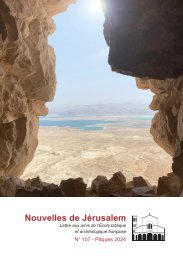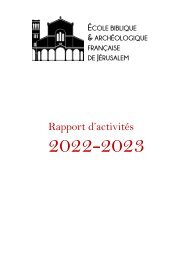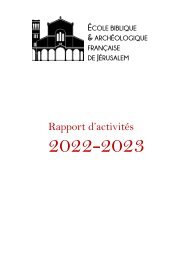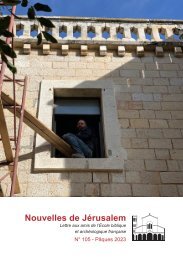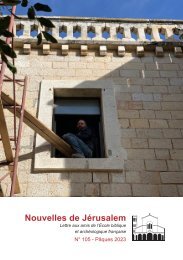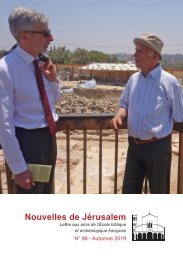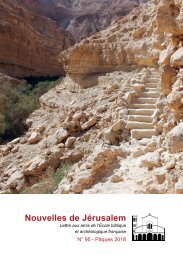NOUVELLES DE JÉRUSALEM - Automne 2017
Les Nouvelles de Jérusalem sont une revue d'informations de l'École biblique et archéologique française de Jérusalem, 2 à 3 fois par an, elles donnent un aperçu des travaux en cours en exégèse comme en archéologie, ici à Jérusalem. En voici le deuxième numéro couleurs en ligne. Les articles alternent français et anglais. The Nouvelles de Jérusalem is an information review of the École Biblique et Archéologique française de Jérusalem, 2-3 times a year, they give an overview of the work in progress in both exegesis and archeology, here in Jerusalem. Here is the second color edition online. Articles are sometimes in French sometimes in English.
Les Nouvelles de Jérusalem sont une revue d'informations de l'École biblique et archéologique française de Jérusalem, 2 à 3 fois par an, elles donnent un aperçu des travaux en cours en exégèse comme en archéologie, ici à Jérusalem. En voici le deuxième numéro couleurs en ligne. Les articles alternent français et anglais.
The Nouvelles de Jérusalem is an information review of the École Biblique et Archéologique française de Jérusalem, 2-3 times a year, they give an overview of the work in progress in both exegesis and archeology, here in Jerusalem. Here is the second color edition online. Articles are sometimes in French sometimes in English.
Create successful ePaper yourself
Turn your PDF publications into a flip-book with our unique Google optimized e-Paper software.
ute to this process by forgiving<br />
monetary debts. This distinction<br />
is exemplified in Luke 7 through<br />
the parable of the Two Debtors<br />
that Jesus tells in order to flesh<br />
out the significance of the woman’s<br />
charitable actions. Her act<br />
of hospitality is construed as a fit<br />
display of repentance and hence<br />
a trustworthy means of securing<br />
divine forgiveness.<br />
The book then turns to consider<br />
the way in which the command to<br />
love one’s neighbor (Lev 19:18)<br />
is related to charity and how that<br />
exegetical move, in turn, informs<br />
the story of the Good Samaritan<br />
(10:25-37). Giambrone proposes<br />
that the importance of the final<br />
verses of the parable has been<br />
overlooked. He suggests that the<br />
line of credit opened between the<br />
Samaritan and the Innkeeper is<br />
directly related to the motif of a<br />
creditor Christology that he introduced<br />
in the previous chapter.<br />
Variation and paradigms<br />
His final exegetical probe concerns<br />
the difficult story of the Dishonest<br />
Steward (16:1-8) and the Rich Man<br />
and Lazarus (Luke 16:19-31). He<br />
addresses how the two stories are<br />
related and explains the exegetical<br />
value of the non-parabolic<br />
teachings that sit between them<br />
(16:9-18). In this probe, another<br />
variation on the “debt/sin” motif is<br />
discovered and two different soteriological<br />
paradigms are explored:<br />
one governed by the grammar of<br />
repayment, the other by a gracious<br />
remission of debt. Though deference<br />
in the Gospel is shown toward<br />
the later, the former includes<br />
a place for human agency, specifically<br />
that of showing mercy to<br />
the poor. Finally, the importance<br />
of the economic soteriology of<br />
Prov 10:2 (“almsgiving delivers<br />
from death”) – a passage long neglected<br />
in the study of Luke – is<br />
given its due.<br />
The book closes with a discussion<br />
of the work’s theological implications.<br />
Giambrone situates Luke’s<br />
perspective on charity over against<br />
other texts in the New Testament.<br />
He also addresses points of dispute<br />
about the meritorious character of<br />
charitable deeds among Protestant<br />
and Catholic exegetes.<br />
Prof. Gary Anderson<br />
Hesburgh Professor of Catholic<br />
Theology Biblical Studies / Christianity<br />
and Judaism in Antiquity<br />
University of Notre Dame, Indiana<br />
Photothèque<br />
Les clichés de l’École exposés en Jordanie, en<br />
Pologne et aux États-Unis<br />
Jordanie<br />
Jordan River<br />
À Ammân, Institut français de Jordanie<br />
(ex-CCF), Jabal al-Weibdeh,<br />
du 9 au 30 avril <strong>2017</strong>.<br />
Pour le 4 e Image Festival d’Amman,<br />
organisé par M me Linda al-Khoury,<br />
ce sont 15 tirages noir & blanc et<br />
un couleur (diapositive de 1954),<br />
sur l’identité du fleuve Jourdain qui<br />
ont été exposés. Provenance : fonds<br />
des Dominicains, des Assomptionnistes,<br />
des Pères Blancs et des Salésiens.<br />
Tirages faits à Ammân par les<br />
soins de M me al-Khoury. L’ambassadeur<br />
de France en Jordanie, M.<br />
David Bertolotti, était présent au<br />
vernissage.<br />
Lettre aux amis de l’ÉBAF - N° 94 - <strong>Automne</strong> <strong>2017</strong><br />
Identité des lieux et des hommes en<br />
Jordanie - The Identity of Places<br />
and People in Jordan<br />
À Ammân, Institut espagnol Cervantès,<br />
IIIe Cercle, Jabal Amman,<br />
du 11 au 22 avril <strong>2017</strong>. Dans le cadre<br />
du même Festival dont le thème général<br />
était cette année « Identity »,<br />
49 tirages noir & blanc : les villes<br />
ou villages d’autrefois en Jordanie,<br />
y compris la capitale, et des types<br />
humains.<br />
Pologne<br />
Jérusalem pérennisée - Jerozolima<br />
utrwalona<br />
À Cracovie, dans le cloître du couvent<br />
des pères Dominicains de la<br />
ville. L’exposition s’inscrivait dans<br />
22 23




